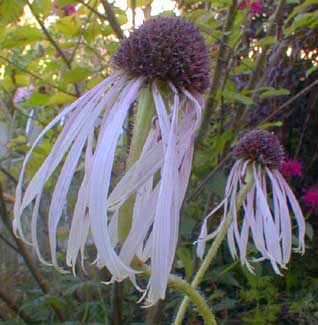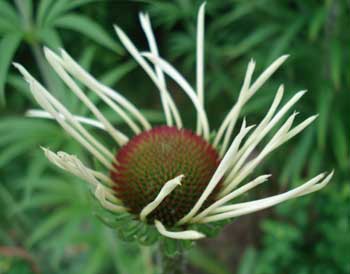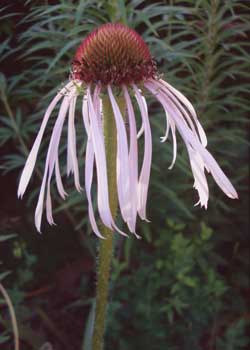
Pale Coneflower
"And on the prairie
The wildflower blows."
-Jack Kerouac
(1922-1969)
(1922-1969)
Native to much of the central United States & Canadian prairies, Echinacea pallida tolerates rather dry conditions but to do its best prefers moist extremely well draining soil.
 Here in the Northwest it wants full sun, but in warmer areas likes a tiny bit of shade. It is not fussy for soil conditions.
Here in the Northwest it wants full sun, but in warmer areas likes a tiny bit of shade. It is not fussy for soil conditions.The reflexed blossoms of the more commonly gardened E. purpurea are much less exaggeratedly pendulous than is the case for E. pallida, the spidery petals for which hang like a flowing mane.
Sometimes called the Pale Purple or Pink Coneflower, the petals color can vary; I'd think Lavender Coneflower would be closer to expressing its average color.
It blooms in our zone beginning early to late July & all of August, with rebloom at least until September. It will bloom earlier in warmer areas. The basal foliage is upright, strappy or grassy. Clumps spread slowly & will require division about every four years.
 They commonly stand three feet tall in flower, often taller; ours produces flower stems five to five & a half feet high, with the foliage only two feet high.
They commonly stand three feet tall in flower, often taller; ours produces flower stems five to five & a half feet high, with the foliage only two feet high.The red-brown cone remains upright into winter, even after the petals have worn away. Finches will cling to the stem & pick seeds from the cone.
E. angustifolia, E. pallida & E. purpurea are the three species most often harvested for root extracts sold as medications for common cold & other ailments. Although many vendors & uncritical herb promoters swear it is "proven" that echinacea cures or prevents colds, bronchitis, & so on, the actual science indicates no such thing.
Authentic medicinal effect has proven illusive when studies are carefully arranged in doubleblind controlled comparisons. The "values" touted by herbalists turn out to be exactly equal to the values of placebo. The more hopeful studies rely on subjective reports.
The popular claim that echinacea extract boosts the immune system is no more or less true than it is of potatoes or strawberries. The antioxidants in many food items, including potentially echinacea, are healthful; but there is no additional boost from echinacea above many ordinary food items which are an actual normal part of daily diet.
E. pallida extract does however contain caffeic acid which might have a temporary effect comparable to weak coffee, & might have a noticeable effect on individuals who do not ordinarily drink tea or coffee & so are more sensitive to caffeine. A cup of coffee would, of course, have a much stronger effect.
Realistically echinaceas should be grown as ornamentals, not medicines, & E. pallida has a very high quotient of ornamentality.
Continue to:
'Kim's Knee High' Echinacea